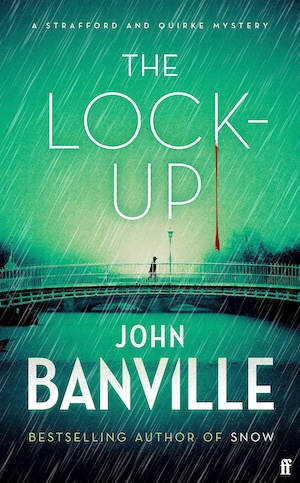
Detective Inspector Strafford and Doctor Quirke return in The Lock-Up, the third instalment of John Banville’s crime duo series. The story picks up where April in Spain finished and deals with the murder of a young Jewish woman, Rosa Jacobs, in Dublin in the 1950s.
The 27-year-old postgraduate history student is discovered dead in one of car mechanic Perry Otway’s central Dublin garage lock-ups. Rosa committed suicide by inhaling carbon monoxide fumes from her car’s exhaust. John Strafford is called out to investigate and the still grieving Doctor Quirke is on-site to give his opinion on the case.
Quirke tends to see things others miss and looks at a crime scene and its victims through the eyes of a pathologist rather than a detective. Their collaboration is a challenging one – Quirke despises Strafford, even more so after what happened in Spain, and Strafford can’t bear to be in the same room as the abrasive doctor. Despite the apparent similarities, they are hardly Holmes and Watson.
Quirke’s theory is that Rosa was drugged first and then placed in the car to suffocate but Chief Inspector Hackett is in no mood for complex cases or Quirke’s theories. He just wants to retire and collect his gold watch and handshake in a few years.
Quirke isn’t the most endearing character, which is understandable given that he recently lost his second wife. His proclivity for alcohol does little to improve his demeanour and his daughter, Phoebe, is frequently on the receiving end. Quirke moved in with his daughter after Evelyn’s tragic death, which he blames on Stafford because he could only kill her murderer after she was fatally shot. For the first few years of her life, Phoebe thought Quirke was her uncle after he abandoned her after her mother’s death. The father-daughter relationship is strained and is under even more duress when Strafford shows an interest in Phoebe.
Of the two main characters Strafford is the solid, dependable and more likeable one. He initially studied law, but left after a few months to join the garda. Like his marriage he drifted into his career and people often remark that he’s not what one expects an Irish detective to be. Yet, he knows how to handle unusual circumstances because of his own outsider status. Being a Protestant loyalist in the Republic of Ireland has its challenges.
Despite their mutual animosity, Strafford and Quirke attempt to connect the dots that could lead to Rosa’s murderer. There are several theories, including her ties to an old, wealthy German family, Phoebe’s ex-boyfriend, Quirke’s ex-colleague and a woman who researched an Israeli nuclear weapons plan. Rosa’s reputation is tainted posthumously by people implying that her loose morals, rebellious nature and always getting herself into trouble led to her death.
Rosa’s murder frequently takes a back seat to John Banville’s in-depth examination of his characters’ personalities, histories, and psychological makeup. This makes it feel as if we’re veering into literary fiction with a strong emphasis on character development rather than a pulsating plot driving the novel. The use of extensive, page-long descriptions of people and objects is also notable. For example, the furniture in the German family’s home and their Alsatian take up paragraphs, and one wonders if these meandering details are really that important. It’s hardly surprising. The author is well-known for both his literary and crime novels, but in recent years there has been a blurring of the lines.
The characters reminisce an mull things over a great deal. Quirke, in particular, spends an inordinate amount of time standing in front of windows, lost in thought. Sometimes the flashbacks are about his wife’s death, other times they are about an attractive girl he once saw in Paris or the ‘erotic tremor’ he felt when he was pick pocketed in London. When Quirke isn’t swooning over women, he’s fuming with pent-up rage against the world and his immediate surroundings. Stafford quips that he burns the air around him like phosphorus. His moody behaviour borders on that of a spoilt child and even though we should sympathise, it’s hard to.
Readers will quickly infer that it is the work of a male author, most likely an older male author, even without knowing who the writer is. Unfortunately, the issue of the male gaze is further exacerbated by remarks about women’s clothing and bodies. On the other hand, this is 1950s Ireland? Also, for someone who’s supposed to be grieving Quirke has quite a surprising sexual interest in women and no qualms in starting a sexual relationship with the murder victim’s sister. Quirke clearly has an itch to scratch. Even an open suitcase in Rosa’s sister’s room becomes a ‘faintly suggestive’ object in his eyes.
Whether you like Banville’s writing style depends greatly on your preference for plot or character-driven crime fiction. Some sections reminded me of Sebastian Barry’s Old God’s Time, but Barry inserts a lightness through humour into his work which is mostly absent here. Maybe it’s time Banville gets his main character out of his own head and onto the streets of Dublin.
For more Irish flavour try the crime drama North Sea Connection.
Faber
Print/Kindle
£15.47
CFL Rating: 3 Stars









